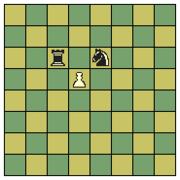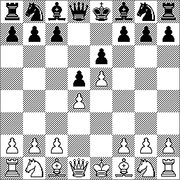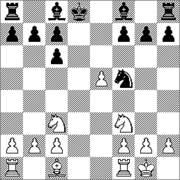Pawn (chess)
|
|
| Chess pieces | |
|---|---|
| | King |
| | Queen |
| | Rook |
| | Bishop |
| | Knight |
| | Pawn |
The pawn (♙♟) is the weakest and most numerous piece in the game of chess, representing infantry, or more particularly pikemen. Each player begins the game with eight pawns, one on each square of the second rank from the view of the player. In algebraic notation the white pawns start on a2, b2, c2, ..., h2, while the black pawns start on a7, b7, c7, ..., h7. Pawns are differentiated by the files in which they currently stand, for example one speaks of "white's f-pawn". Sometimes, however, pawns are still referred to using descriptive notation, e.g. "white's king's bishop's pawn".
| Contents |
Movement
Cb_pawn_move.png
Pawns are unusual in movement and use. Unlike all the other pieces, pawns may not move backwards. Normally a pawn moves by advancing a single square, but the first time each pawn is moved from its initial position, it has the option to advance two squares. Pawns may not use the initial two-square advance to jump over an occupied square, or to capture. In the diagram at left, the pawn on c4 may move to c5, while the pawn on e2 may move to either e3 or e4.
Capturing
Cb_pawn_ep.png
Unlike other pieces, the pawn does not capture in the same way as it moves. A pawn captures diagonally, one square forward and to the left or right. In the diagram to the right, the white pawn may capture either the black rook or the black knight. Any piece directly in front of a pawn, friend or foe, blocks its advance.
An even more unusual move is the en passant capture. This arises when a pawn uses its initial-move option to advance two squares instead of one, and in so doing passes over a square that is attacked by an enemy pawn. That enemy pawn, which would have been able to capture the moving pawn had it advanced only one square, is entitled to capture the moving pawn "in passing" as if it had advanced only one square. The capturing pawn moves into the empty square over which the moving pawn moved, and the moving pawn is removed from the board. In the diagram at right, the black pawn has just moved c7 to c5, so the white pawn may capture it by moving from d5 to c6. The option to capture en passant must be exercised on the move immediately following the double-square pawn advance, or it is lost and may not be made later. The en passant move was added to the pawn's repertoir in the late 13th century to compensate for the then newly added two-square initial move rule. Without en passant, a pawn could simply march past squares guarded by opposing pawns, en passant preserves the restictive ability of pawns that have reached the 5th rank.
Promotion
Finally, a pawn that advances all the way to the opposite side of the board (the opposing player's first rank) is promoted to another piece of that player's choice. The pawn is immediately (before the opposing player's next move) replaced by a queen, rook, bishop, or knight of the same color. Promotion is often called "queening", because the piece chosen is nearly always a queen. When some other piece is chosen it is known as underpromotion and the piece selected is usually a knight. This will typically be done only if this enables a forced mate.
In practice, a promoted pawn is often replaced with a piece previously captured, because most standard chess sets do not come with additional pieces. (Some finer sets do have an extra queen of each color, though.) The choice of promotion, however is not limited to captured pieces. It is perfectly acceptable to have, say, three to ten knights, bishops, or rooks, or two to nine queens simultaneously in play. In fact, game eleven of the 1927 world championship match between José Raúl Capablanca and Alexander Alekhine featured four queens on the board. When extra pieces are not available, a second queen is often indicated by an inverted rook. In computer chess, of course, there is no need for the use of captured or additional pieces.
Strategy
Pawns are the source of nearly all of the strategic depth of chess. If other pieces are temporarily badly placed, they can usually be regrouped more favorably. A poorly placed pawn, in contrast, cannot retreat to a more favorable position, it can only advance further.
Because pawns capture diagonally and can be blocked from moving straight forward, opposing pawns often become locked in diagonal chains of two or three, where each player controls squares of one color. In the diagram at left, black and white have locked their d- and e-pawns.
Generally speaking, the pawn structure determines the strategic flavor of a game. In the diagram at left, White has a long-term space advantage. White will have an easier time than Black in finding good spaces for friendly pieces, particularly with an eye to a kingside attack. Black, in contrast, suffers from a bad bishop on c8, which is prevented by the black pawns from finding a good square and/or helping out on the kingside.
On the other hand, White's central pawns are somewhat over-extended and vulnerable to attack. Black can undermine the white pawn chain with an immediate c7-c5 and perhaps a later f7-f6. An advanced piece, when attacked, has the option of retreating, but far advanced pawns are sitting targets.
Chess_pawn_isolated.png
Pawns on adjacent files are strong, because they can support each other in attack and defense. A pawn which has no friendly pawns in neighboring files is an isolated pawn. The square in front of an isolated pawn may become an enduring weakness. Any piece placed directly in front not only blocks the advance of that pawn, but can't be driven away by other pawns.
In the diagram at right, Black has an isolated pawn on d5. If all the pieces except the kings and pawns were removed, the weakness of d4 might prove fatal to Black in the endgame. In the middlegame, however, Black has slightly more freedom of movement than White, and may be able to trade off the isolated pawn before an endgame ensues.
Chess_pawn_passed.png
A pawn which can't be blocked or captured by enemy pawns in its advance to promotion is a passed pawn. In the diagram at left, White has a passed pawn on a4. Black's pawn on g7 is not a passed pawn, because it has to get by White's h2 pawn before it can be promoted. Because endgames are almost always won by the player who can promote a pawn first, having a passed pawn is often decisive.
The diagrammed position might appear roughly equal, because each side has a king and five pawns, and the positions of the kings are about equal. In truth, White has a won game merely on the strength of the passed pawn, no matter who makes the first move.
Sometimes, due to captures, a player may end up with two pawns in the same file, which are then called doubled pawns. Doubled pawns are substantially weaker than pawns which are side by side, because they can't defend each other, and the front pawn blocks the advance of the back one. In the diagram at right, Black is playing at a strategic disadvantage due to the doubled c-pawns. A chessplayer should not cling too firmly to this rule of thumb: there are situations where doubled pawns are the source of a positional advantage, although it can of course be converted to a disadvantage later on.
Even weaker than doubled pawns are pawns which are doubled and isolated. A single piece or pawn in front of doubled isolated pawns blocks both of them, and cannot be easily dislodged.
It is rare for a player to have three pawns in a file, i.e. tripled pawns, but it does happen in real games. Depending on the position, tripled pawns may be more or less valuable than two pawns which are side by side.
Because the pawn is the weakest piece, it is often used metaphorically to indicate unimportance or outright disposability, for example, "I'm only a pawn in the game of life."
Quotes
- "The pawns are the soul of chess." - Philidor
See also
da:Bonde (skak) de:Bauer (Schach) el:Πιόνι (σκάκι) eo:Peono (sxako) es:Peón (ajedrez) it:Pedone (scacchi) nl:Pion (schaken) ja:ポーン pl:Pion (szachy) pt:Peão (xadrez) ru:Пешка sl:Kmet (šah)



